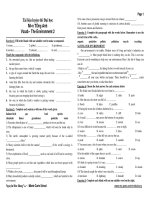toan Tieng Anh " The Distance"
Bạn đang xem bản rút gọn của tài liệu. Xem và tải ngay bản đầy đủ của tài liệu tại đây (203.86 KB, 9 trang )
THE DISTANCE
Introducing terms used in the
lesson
•
perpendicular
•
parallel
•
projector
•
right triangle
•
square
•
distance
A
D
B
C
S
K
I. The distance from a point to a line:
•
Give the line a and one point O.
a
O
H
M
We get the distance from O to the line a is the
length of OH. The notation is: d(O,a) = OH = d.
For all M on the line (a), we can see that OH OM
(OH is less than or equal to OM). Hence, d is the
least length from O to any point on the line.
•
Let H is the projector of O on the line a.
≤
II. The distance from a point to a plane:
•
Give the plane (P) and one point O, H is the projector of O
on the plane.
•
We get the distance from O to (P) is the length of OH.
The notation is d(O;(P)) = d = OH.
•
For all M on the plane, we can see that OH OM (OH
is less than or equal OM).
•
Hence, d is the least length from O to any point on
the plane.
≤
III. The distance from a line to a
plane that is parallel to that line.
•
Let d is the distance from the line a to the plane (P)
that is parallel to a.
•
We define that d is equal to the distance from any
point on the line a to the plane (P).
The notation is: d(a,(P)) = MH
Example
•
Let S.ABCD be pyramid with ABCD is a
square edge a , SA is perpendicular to the
plane (ABCD) and the length of the line
SA = .
a) Calculate the distance from A to plane
(SCD).
b) Calculate the distance between the
straight line CD and mp (SAB).
a 2
1) Let H is the projector of A on the line SD.
•
We see: SD ⊥ AH (1)
•
Moreover CD ⊥ AD, CD ⊥ AD so CD ⊥ (SAD)
imply CD ⊥ AH. (2)
•
From (1), (2), We get AH ⊥ (SCD)
•
Hence AH = d(A,(SCD))
2) We calculated AH = 2) We see CD parallel to
(SAB) so d(CD, (SAB)) = d(D,(SAB)) = AD = a
A
D
B
C
S
K
•
Exercise 1: Let ABC.A′B′C′ be prismatic
with AA ⊥ (ABC), AA′ = a, right triangle
ABC at A where BC = 2a, AB = a.
Calculate:
a) The distance from line AA′ to the plane
(BCC′B′).
b) The distance from A to (A ′ BC).
c) Prove that AB ⊥ (ACC’A’) and the
distance from point A′ to the plane (ABC’).









